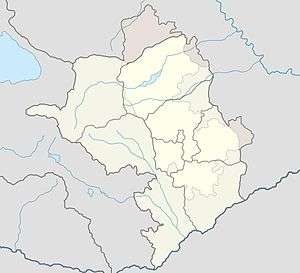Ghazanchetsots Cathedral
| Ghazanchetsots Cathedral | |
|---|---|
|
The restored Cathedral of Ghazanchetsots and the bell-tower. | |
 Location within the disputed Nagorno-Karabakh region. | |
| Basic information | |
| Location |
Shusha (Shushi) de facto: Nagorno-Karabakh Republic de jure: Azerbaijan |
| Geographic coordinates | 39°45′32″N 46°44′52″E / 39.758819°N 46.747883°ECoordinates: 39°45′32″N 46°44′52″E / 39.758819°N 46.747883°E |
| Affiliation | Armenian Apostolic Church |
| Architectural description | |
| Architectural style | Armenian |
| Groundbreaking | 1868 |
| Completed | 1887 |
Ghazanchetsots Cathedral (Armenian: Սուրբ Ղազանչեցոց, Surb Ghazanchetsots), also known as the Cathedral of Christ the Holy Savior (Ղազանչեցոց Սուրբ Ամենափրկիչ Մայր Տաճար Ghazanchets'ots' Surb Amenap'rkich Mayr Tachar), is an Armenian church located in Shusha, Nagorno-Karabakh.
History

Ghazanchetsots Cathedral was built between 1868 and 1887 and has a facade of white limestone.[1] Its architect, Simon Ter-Hakobyan, intended the church to resemble Etchmiadzin Cathedral. In front of the west entrance is a freestanding three-story bell tower, constructed in 1858. Large statues of angels blowing trumpets stood at each corner of the bell tower's second story. However, they were destroyed during the Nagorno-Karabakh War when Shusha was under Azeri control.[2]
The cathedral has seen a number of uses over the years. Its use as a functioning church ended after the Shusha pogrom of 1920. During the Soviet period it was used as a granary, and then as a garage. During the Nagorno-Karabakh War, Azerbaijani forces used the cathedral as a GRAD munitions storehouse until May 1992,[3] when Shusha was captured by Armenian forces. In the years after that capture the church was repaired and renovated. Replica angel statues were made to replace the destroyed originals; an image of one forms part of the coat-of-arms of Shusha. In 1998 it was re-consecrated as a church, and now serves as the main cathedral and headquarters of the Armenian Apostolic Church's Diocese of Artsakh.[4]
Gallery
| Wikimedia Commons has media related to Shushi Cathedral. |
 2006
2006 2007
2007- 2013
 2014
2014- Looking up towards the dome of the cathedral
- A mural of Saint Peter
- The pews of the cathedral
.jpg) The belfry
The belfry.jpg) Statue of an angel
Statue of an angel Evening view of Ghazanchetsots Cathedral skyline.
Evening view of Ghazanchetsots Cathedral skyline.
See also
Notes
- ↑ Hasratyan, Murad M. Շուշի (Shushi). Armenian Soviet Encyclopedia. vol. viii. Yerevan: Armenian Academy of Sciences, 1982, p. 601.
- ↑ Hasratyan, Murad and Zaven Sargsyan. Armenia: 1700 Years of Christian Architecture. Yerevan: Mughni Publishing, 2001. p. 234.
- ↑ De Waal, Thomas. Black Garden: Armenia and Azerbaijan through Peace and War. New York: New York University Press, 2003, pp. 179-180, 190. ISBN 0-8147-1944-9.
- ↑ Hasratyan and Sargsyan. Armenia, p. 234.

.jpg)